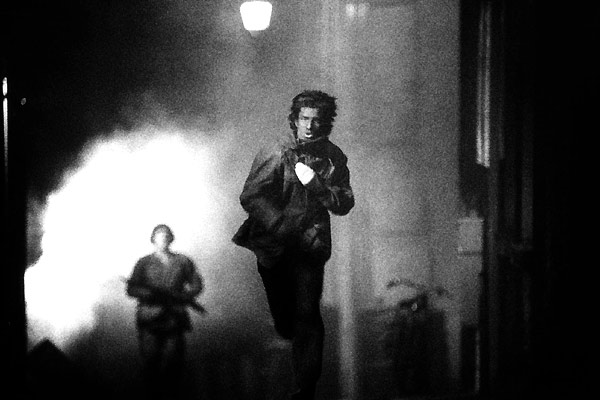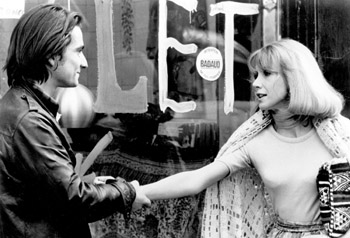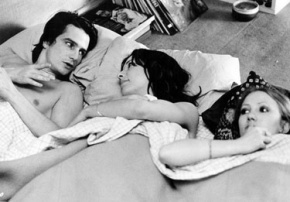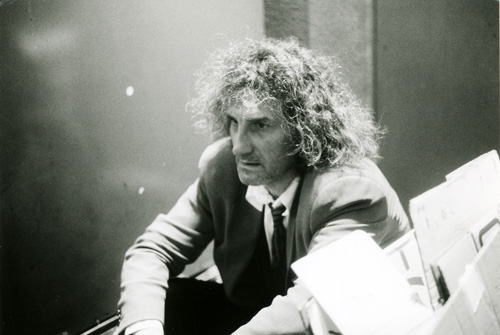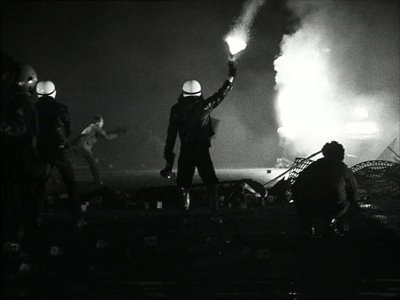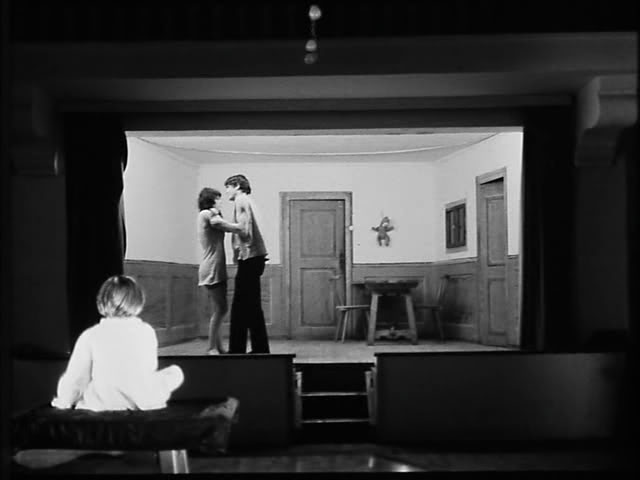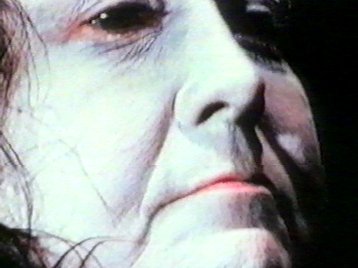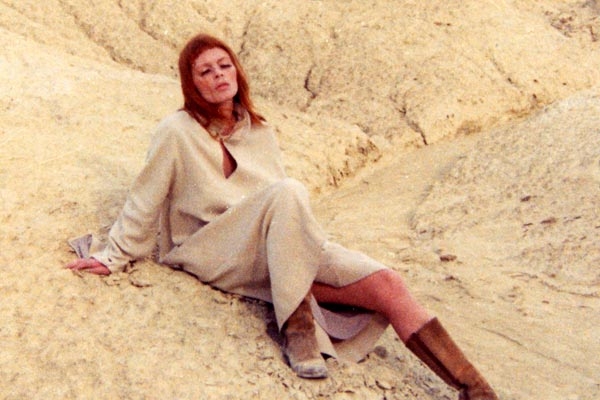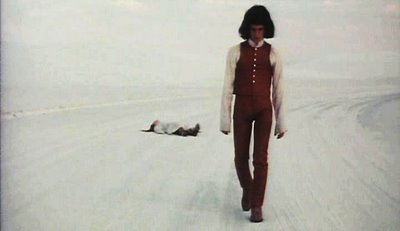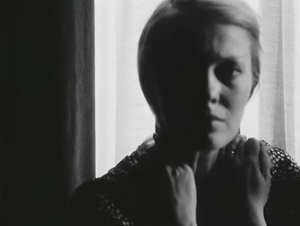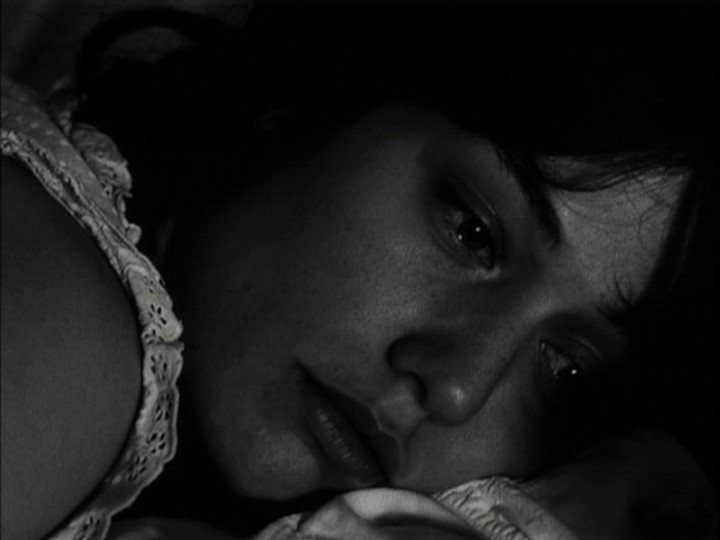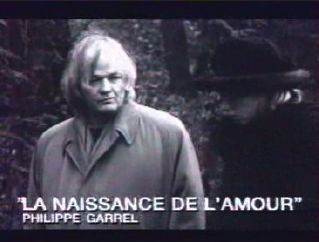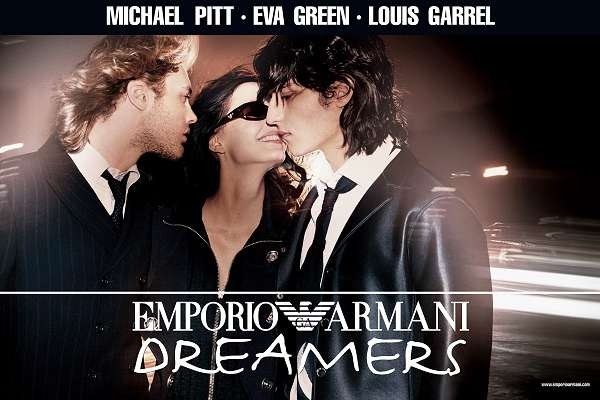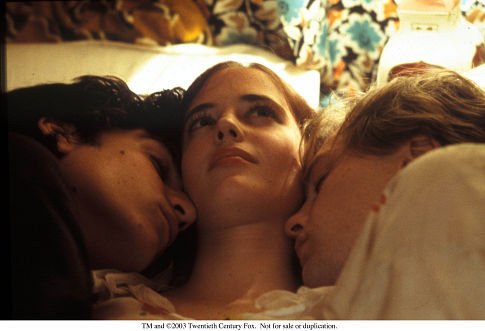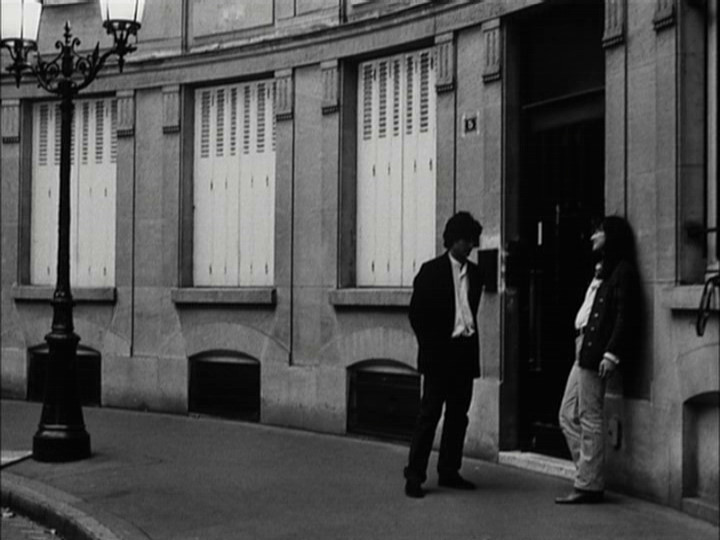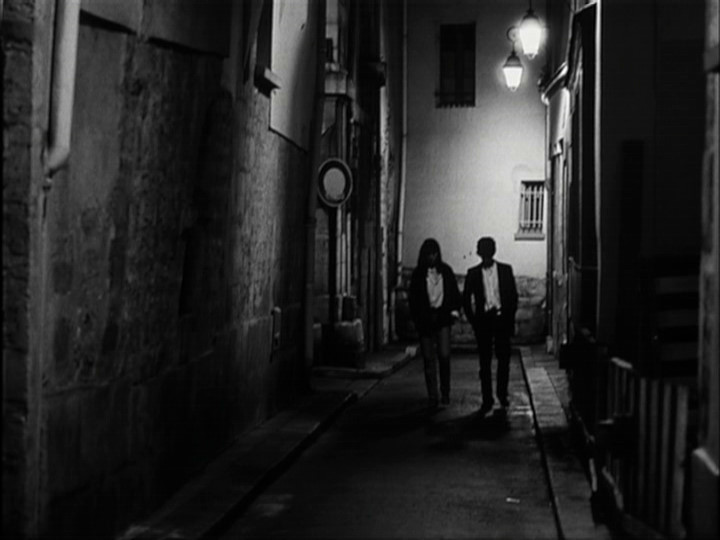Commissioned by Sight and Sound, and written for their August 2006 issue. — J.R.
Considering how much admiration I have for the films of Philippe Garrel, it’s hard to avoid some feelings of guilt and consternation for not liking them more — especially when I consider how much they mean to others whose tastes I admire. Why do I find myself preferring the work of his best-known disciple, Leos Carax?
This is a problem I’ve been wrestling with for a quarter of a century. For the past decade, I’ve been trying to theorize my disaffection by ascribing the passion of my younger friends for this melancholy star of the French underground to a generational taste I can’t share. In some respects, I even like the way they like Garrel’s films more than I like the films themselves. They generate a kind of awe that few other filmmakers inspire, and the fact that he’s a minority taste in no way disqualifies him from being a major talent.
These far-flung cinéphiles, all born around 1960, include Nicole Brenez, based in Paris; Alexander Horwath, based in Vienna; Kent Jones, based in New York; and Adrian Martin, based in Melbourne —- all of whom share similarly acute feelings for John Cassavetes, Abel Ferrara, Monte Hellman, and Maurice Pialat. They all collaborated on a 2003 book I co-edited with Martin, Movie Mutations: The Changing Face of World Cinephilia (BFI Publishing) -— a book that started out as an attempt to account for their curious synchronicity of interests. More recently, I’ve been discussing Garrel’s latest film with South Korean cinéphiles who saw it at the Jeonju International Film Festival, many of whom singled it out as their favorite film of the past year —- a sentiment shared by several western friends and acquaintances.
Strangely, most die-hard Garrel fans I know were born over a decade later than him, whereas I was born five years earlier. So the problem obviously can’t be reduced to simple time frames. I feel far more in tune with Jean Eustache, born in 1938, and Jacques Rivette, born in 1928, than I do with Garrel, born in 1948. The post-1968 political despair in the separate 12 and 4-hour versions of Rivette’s Out 1 (1971/72) and Eustache’s The Mother and the Whore (1973) all speak to me directly and even urgently, whereas Garrel’s recent Les Amants Réguliers (Regular Lovers, 2004), which attacks the same subject in an even more literal fashion, seems to be addressing a different constituency entirely.
Rivette’s desperate vision is fully tuned into 60s madness and Eustache’s angry vision is equally tuned into 60s neurosis. But Garrel’s lament is neither desperate nor angry, and his `regular’ lovers are basically innocents, basking or drowning in the banality of bourgeois comforts. Maybe my friends and I were doing the same thing, but I can’t recognize the portrait either poetically or otherwise. Rightly or wrongly, we were fighting a game that had stakes; these charming deadbeats don’t appear to be.
At least I can agree with my younger friends that Garrel’s three-hour epic about Parisian youth in 1968 belongs somewhere near the peak of his oeuvre to date. Shot in exquisite high-contrast black and white by William Lubtchansky, and virtually beginning with an account of the May ’68 street skirmishes, it distills the brooding melancholy of Garrel’s work as a whole into a nocturnal reverie about retreat that certainly reverberates. But I can’t say I’m easily reconciled with the hopelessness of its vision, So maybe it can also serve as a useful index of why and how certain tastes and historical understandings differ.
***
As a side-product of my long-term theorizing, I was honored to have been the sole dissenter invited in June 2001 to participate in what was probably the only Garrel conference that has ever been held anywhere. As an immediate follow-up to the four-day For Ever Godard symposium held at the London’s Tate Modern, a much more modest but no less intense two-day gathering, Garrel éternel, was held at Dublin’s Irish Film Centre. The combined panelists and audience came to scarcely more than a dozen people, but the energy never flagged.
An observation emerging shortly afterwards in the online Senses of Cinema, in an open letter to Martin from the conference’s organizer, Fergus Daly, came closest to explaining my distance from the others. Alluding to `this preoccupation with the couple and little else (a persistent one in Garrel),’ Daly noted that ‘For those like you and I who developed their affective lines of investment and expectation as adolescents in the late ’70s, politics in the accepted (macro-) sense was already a thing of the past — art and love seemed the only things that mattered.’
This is clearly true of the characters during the second two-thirds of Les Amants Réguliers. And it can’t help but affect the way we view the characters’ politics —- and how we view the characters politically — during the first third.
***
Garrel’s first films were made in his teens, shortly before the upheavals of ’68; apart from the one-hour, black and white Le Révélateur, which was briefly available in France on video, these remain impossible for most people to see today. Based on what I’ve sampled, and not counting his TV commissions of that period (basically documentaries, including one about Godard), they resemble his subsequent work insofar as they’re mainly autobiographical, focus on homey and everyday details while remaining detached and painterly, inspired by silent cinema (and, in the case of Le Révélateur — which critic Brad Stevens has compared to David Lynch’s The Grandmother —- literally silent), and employ actors associated with the French New Wave (including Garrel’s own father Maurice, who worked for Jacques Rozier and François Truffaut, as well as Bernadette Lafont, Jean-Pierre Léaud, and Zouzou). And unlike many other experimental films, they’re mostly in 35-millimeter.
Some of Garrel’s more ambitious films of the ‘60s and ‘70s also take on certain epic and mythopoetic dimensions. The best known of these is probably his 1971 La Cicatrice Intérieure (The Inner Scar), shot in deserts found in Egypt, Iceland, Italy, and New Mexico, with Pierre Clémenti, Clémenti’s infant son Balthazar, Daniel Pommereuille, Garrel himself, and Warhol superstar Nico. The latter went on to become the love of Garrel’s life; his next half-dozen films were made with her, and it appears that most of those made after their separation and her death continue to evoke her in one way or another. The only other Garrel film with Nico I’ve seen, Les Hautes Solitudes (1974), is another silent feature, relatively non-fictional; Jean Seberg, Tina Aumont, and Laurent Terzieff also appear in it, and the voyeuristic way it views Seberg, sometimes while she’s either sleeping or just waking up, struck me as intrusive when I saw it at the Dublin conference. It’s a development that heralds some of the more violent psychodramas found in the later narrative features.
Since the ‘70s, Garrel has spent much of his time recasting his brooding style in terms more compatible with narrative conventions and arthouse norms — Brenez has written persuasively about the ways his films might be regarded as Bressonian — while sustaining most of his autobiographical preoccupations and never compromising his vision one iota. The influence of silent cinema, for instance, remains in force, becoming especially apparent in his uses of solo piano for musical accompaniments, including the effective score by Jean-Claude Vannier in Les Amants Réguliers. No less relevant are that film’s poetic intertitles introducing various sections — despite the irony with which they’re used, which often seems to reflect the irony of the brief, enigmatic fantasy sequences evoking 18th century military battles. In both these instances, Garrel seems to be looking back on his younger self with a certain indulgent skepticism, meanwhile projecting an overall sympathy towards all his other characters, including even the cops, that is both refreshing and unexpected. Gabe Klinger, writing online, has even plausibly compared him to Jean Renoir.
***
Until fairly recently, the Paris Cinémathèque was mainly inhospitable to and incurious about contemporary experimental films. But Garrel, a particular favorite of Henri Langlois (who regarded La Cicatrice Intérieure as a ‘total masterpiece’), was a notable exception, and the fact that he grew up in some proximity to the local film world because of his father probably helped to establish him early on as a legendary as well as highly respected figure. As Cahiers du Cinéma’s Jean Douchet has observed, Garrel `occupies a singular position within French cinema’ because his ‘small but devoted public’ is essentially the one that has traditionally developed in France around poets. (Douchet adds that Garrel’s tradition is closer to André Breton’s in his Nadja mode than to Jean Cocteau’s, and that `his cinema descends in a direct line from that of Lumière, not that of Méliès.’)
As with Werner Schroeter in West Germany and Carmelo Bene in Italy —- two other avant-garde masters of slow-motion portraiture who developed over the same period — another pertinent parallel might be to chamber music. Even though Garrel pitched his own tent far from the operatic and camp registers of Schroeter and Bene, there’s a similar sense of transporting the viewer to a meditative, almost nonnarrative realm, a soft and somber perpetual present similar to the intimate world of a string quartet. Whatever one’s qualms, it’s a kind of cinema that needs defending today more than ever. Thanks to digital technology, making chamber pieces is theoretically much easier than it used to be, yet thanks to advertising and multicorporate monopolies, finding one’s way to such works and other niche market items is a good deal harder.
In this respect, Garrel might be regarded as a kind of romantic luxury that only a culture such as France’s can fully support, or perhaps envision: relatively free from most commercial restraints, including many of the usual obligations associated with telling a story; surviving on the fringes of art cinema (where Garrel eventually settled by the early 80s) while retaining the same overall ambitions; defiantly remaining, as Kent Jones put it in the title of one appreciation, ‘Sad But Proud of It’.
It isn’t clear to me whether Garrel met Nico before or after he became a heroin addict. I suspect it was after, because opium plays a significant role in Les Amants Réguliers and Nico, apart from the use of her song “Vegas,” seemingly doesn’t — though it’s surely wrong to treat the autobiographical elements in his films too literally. But it does seem evident that Nico and heroin were the two key elements in Garrel’s life during the ‘70s, that they largely overlap, and that they both have haunted his work ever since. François, the 20-year-old hero of Les Amants Réguliers, played by his son Louis, is identified as a talented poet but not as a filmmaker, and Lilie (Clotilde Hesme), his lover, whom he meets on the streets during May ’68, is a French sculptress of roughly the same age, not a German-born pop vocalist who’s ten years older.
***
Among the psychodramas of Garrel that I’ve seen, the two that I’ve found most compelling are Liberté, la nuit (1983) and La Naissance de l’amour (The Birth of Love, 1993), both in black and white. The former — Garrel’s only period film prior to Les Amants Réguliers — is set during the Algerian war and has highly emotional performances by Emmanuelle Riva, Maurice Garrel, and Christine Boisson. The latter oscillates between an actor (Lou Castel) undergoing a midlife crisis who periodically leaves his wife, teenage son, and infant daughter to sleep with younger women and a friend of his (Jean-Pierre Léaud), a blocked writer who’s just been ditched by his girlfriend and can’t get over her.
Sometimes Garrel’s films are sufficiently direct in their personal references to be about filmmakers and filmmaking. The most complex example is Elle a passé tant d’heures sous les sunlights (1984), which contrives to alternate the stories of two filmmaking couples in a splintered, ambiguous fashion, mixing documentary and self-referential fiction while also including Garrel’s interviews with Chantal Akerman and Jacques Doillon. This 35mm black and white feature led to a 16mm color television documentary four years later, Les Ministères de l’Art, dedicated to the memory of Eustache. Here Garrel interrogates not only Akerman and Doillon, but also, among others, Léaud, Carax, Juliet Berto, Benoît Jacquot, André Téchiné, and Werner Schroeter, most often while taking extended walks with them. He also manages to show his five-year-old son Louis, the future star of Les Amants Réguliers, riding a tricycle around in circles while he pontificates nearby.
Finally, in Sauvage innocence (2001), we find a bitter personal allegory (as well as a teasing film à clé) about filmmaking, again in black and white. A filmmaker (Mehdi Belhaj Kacem) whose wife dies from a drug overdose arranges to make an autobiographical, anti-heroin feature, meanwhile becoming involved with his star (Julia Faure). Then, after he loses financing, he finds it again in exchange for helping the new producer (Michel Subor) — an addict who has meanwhile hooked his leading lady —- smuggle a large quantity of heroin into France.
***
Louis Garrel costarred as one of the three young leads in Bernardo Bertolucci’s The Dreamers (2003), another film set around May ’68. This has understandably led many to interpret Les Amants Réguliers as Garrel’s response to that film —- an interpretation he encourages when he has his characters briefly mention Prima della rivoluzione (1964) and cite Bertolucci by name. It also should be noted that Louis Garrel is one of the clearest assets of both films —-not only due to his skill as an actor but because he physically evokes the era in question, often calling to mind Léaud.
But it should be stressed that the characters he plays in the two films are different, even if both come from unusually privileged and educated backgrounds. Theo — his more cocky character in The Dreamers, who throws a Molotov cocktail just to be part of the action — is a far cry from François, a more vulnerable and sheltered youth who isn’t even sure he should publish his poems (‘It would feel like betraying something — although I don’t know what’) — though his writing talent is seemingly what wins him a suspended sentence when he comically goes to trial for evading the draft. (Warning: spoilers ahead.) François, who’s ultimately both likable and doomed, can’t even survive the shock of Lilie breaking up with him —- an act rendered in a masterful two-minute take, shot on the street.
The Dreamers was supposed to show how great it was in 1968 to be young and horny and in Paris and political and smitten with movies seen at the Cinémathèque. But I must confess I was all of those things and the movie brought back none of my experience — perhaps because it was aimed at viewers the same age as Gilbert Adair’s and Bertolucci’s characters, not at me, even though one of those characters was an American cinephile like myself. Admittedly, I’d arrived in Paris that summer by mid-June, just after the police had taken the Odéon Theatre back from the students and cleared away the makeshift street barricades. But remnants of felled trees still lined portions of Boulevard St-Michel, and the city felt strangely energized. I found myself fleeing from a police charge one day and getting a sudden and potent whiff of tear gas on another.
Garrel’s film is only about French kids, and it starts rather than ends with the May events. It understandably feels much more authentic because Garrel was a participant in the May events (albeit a `very nonviolent’ one, by his own account) as well as an observer. As filmmaker Jackie Raynal, who worked as Garrel’s editor and assistant director during this period, once told me in an interview, ‘Godard had an Alfa Romeo with a 35mm camera [at the time], and he and Alain Jouffroy and Garrel went around shooting footage,’ adding that, ‘Because of the Alfa Romeo, the police left them alone.’ (The ten-minute collective film that resulted, Actua I, which Godard has praised, was lost in a processing lab and never seen again.)
Authentic or not, Garrel’s treatment of the event is arguably no less postpolitical (or prepolitical) than Bertolucci’s. One can admire his honesty about his characters’ overall lethargy without being entranced by the lethargy itself, as some viewers apparently are. (Paradoxically, the nostalgia attached nowadays to black and white films automatically gives this film’s surfaces a certain allure.) Given how supportive Francois’ parents (and his grandfather, played by Maurice Garrel) are of his street activism, he doesn’t come across as much of a rebel. The political discourse we hear (‘Organizing is for sheep; what we want is anarchism’; ‘Can we make a revolution for the working class despite the working class?’) certainly matches the flavor of the period, but its overall function in the film isn’t very far from that of period décor.
Above all, the importance of drugs in Francois’ life is established even before his political concerns are faintly broached — with the result that they can’t help but inform his politics. It isn’t clear to me if he’s smoking hashish or opium with his friends in an early scene. But even if it’s the former, opium clearly becomes the drug of choice soon afterwards. And you don’t have to read the Appendix to William S. Burroughs’ Naked Lunch to understand that the philosophical and political implications of hallucinogenic drugs and those of opiates are virtually antithetical, and were understood as such by a good many radicals of the ‘60s.
This isn’t an understanding Garrel appears to have much truck with. It’s a comprehensible position for a former heroin addict to have, but it can’t illuminate why radicals who smoked grass in the ‘60s didn’t regard their activity as a political copout, whereas those who favored heroin were unlikely to be involved with any sort of politics, except peripherally. Maybe that’s why this film feels, like Keats in `Ode to a Nightingale,’ ‘half in love with easeful Death’ — almost viewing political defeat itself as a kind of voluptuous embrace.

